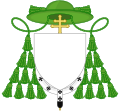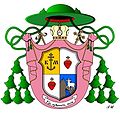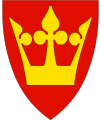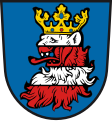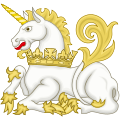Crown (heraldry): Difference between revisions
Arms Jones (talk | contribs) Undid revision 585532191 by Wilhelm meis (talk) because it removed image descriptions which can be important for understanding the text. |
Wilhelm meis (talk | contribs) Please see WP:MOSIM (avoid referring to image position) and WP:CAPTIONS (sentence fragment). "Later" should be "latter", but "kingdom" is already implied by "royal crown" so the phrase is not essential to meaning. |
||
| Line 1: | Line 1: | ||
[[File:Coat of Arms of Norway.svg|thumb|The coat of arms of Norway, displaying a crowned lion |
[[File:Coat of Arms of Norway.svg|thumb|The coat of arms of Norway, displaying a crowned lion on the shield and a royal crown on top of the shield]] |
||
[[File:Coat of arms of Rhineland-Palatinate.svg|thumb|The coat of arms of Rhineland-Palatinate in Germany, displaying a crowned lion in the shield and a [[people's crown]] on top of the shield, the later for the land's status as a republic.]] |
|||
A '''[[Crown (headgear)|Crown]]''' is often an [[emblem]] of the monarchy, a monarch's government, or items endorsed by it; see [[The Crown]]. A specific type of crown (or [[coronet]] for peerage in the British Isles) is employed in [[heraldry]] under strict rules. |
A '''[[Crown (headgear)|Crown]]''' is often an [[emblem]] of the monarchy, a monarch's government, or items endorsed by it; see [[The Crown]]. A specific type of crown (or [[coronet]] for peerage in the British Isles) is employed in [[heraldry]] under strict rules. |
||
Indeed some monarchies never had a physical crown, just a heraldic representation, as in the constitutional kingdom of [[Belgium]]. |
Indeed some monarchies never had a physical crown, just a heraldic representation, as in the constitutional kingdom of [[Belgium]]. |
||
| Line 11: | Line 10: | ||
If the bearer of a coat of arms has the title of [[baron]] or higher (or hereditary [[knight]] in some countries), he or she may display a '''[[coronet]]''' of rank above the shield, usually below the helm in British heraldry, often above the crest (if any) in Continental heraldry. |
If the bearer of a coat of arms has the title of [[baron]] or higher (or hereditary [[knight]] in some countries), he or she may display a '''[[coronet]]''' of rank above the shield, usually below the helm in British heraldry, often above the crest (if any) in Continental heraldry. |
||
In this case the appearance of the crown follows a strict set of rules. A royal coat of arms may display a royal crown such as that of [[Norway]] |
In this case the appearance of the crown follows a strict set of rules. A royal coat of arms may display a royal crown such as that of [[Norway]]. Princely coats of arms display a princely crown and so on right down to the [[mural crown]] which is commonly displayed on coats of arms of towns and some republics. Other republics may use a so called [[people's crown]] or omit the use of crowns all together. The heraldic forms of crowns are often inspired by the actual appearance of the respective country's royal and princely crowns. |
||
Ships and other units of some [[Navy|navies]] have a [[naval crown]] above the shield of their coats of arms. |
Ships and other units of some [[Navy|navies]] have a [[naval crown]] above the shield of their coats of arms. |
||
Revision as of 13:50, 12 December 2013
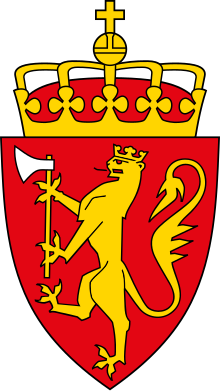
A Crown is often an emblem of the monarchy, a monarch's government, or items endorsed by it; see The Crown. A specific type of crown (or coronet for peerage in the British Isles) is employed in heraldry under strict rules. Indeed some monarchies never had a physical crown, just a heraldic representation, as in the constitutional kingdom of Belgium.
Crowns are also often used as symbols of religious status or veneration, by divinities (or their representation such as a statue) or by their representatives, e.g. the Black Crown of the Karmapa Lama, sometimes used a model for wider use by devotees.
A crown can be a charge in a coat of arms, or set upon the shield to signify the status of its owner.
As a display of rank
If the bearer of a coat of arms has the title of baron or higher (or hereditary knight in some countries), he or she may display a coronet of rank above the shield, usually below the helm in British heraldry, often above the crest (if any) in Continental heraldry.
In this case the appearance of the crown follows a strict set of rules. A royal coat of arms may display a royal crown such as that of Norway. Princely coats of arms display a princely crown and so on right down to the mural crown which is commonly displayed on coats of arms of towns and some republics. Other republics may use a so called people's crown or omit the use of crowns all together. The heraldic forms of crowns are often inspired by the actual appearance of the respective country's royal and princely crowns.
Ships and other units of some navies have a naval crown above the shield of their coats of arms.
Commonwealth usage

In formal English the word crown is reserved for the crown of a monarch whereas the word coronet is used for all other noble crowns.
In the peerage of the United Kingdom, the design of a coronet shows the rank of its owner, as in German, French and various other heraldic traditions. The coronet of a duke has eight strawberry leaves, that of a marquess has four strawberry leaves and four silver balls (known as "pearls", but not actually pearls), that of an earl has eight strawberry leaves and eight "pearls" raised on stalks, that of a viscount has sixteen "pearls", and that of a baron has six "pearls". Since a person entitled to wear a coronet customarily displays it in their coat of arms above the shield and below the helm and crest, this can provide a useful clue as to the owner of a given coat of arms.
Members of the British Royal Family have coronets on their coats of arms, and may wear them at coronations. They are according to regulations made by King Charles II in 1661 shortly after his return from exile in France (getting a taste for its lavish court style; Louis XIV started monumental work at Versailles that year) and Restoration, and vary depending upon the prince's relationship to the Monarch. Occasionally additional royal warrants vary the designs for individuals.
In Canadian heraldry, coronets are used to designate descent from United Empire Loyalists. A military coronet signifies ancestors who served in Loyalist regiments during the American Revolution, while a civil coronet is used by all others. The loyalist coronets are used only in heraldry, never worn.

|
Sovereign - St. Edward's Crown | 
|
Sovereign - Crown of Scotland | 
|
Sovereign - Imperial/Tudor Crown | 
|
Heir Apparent |

|
Prince or Princess - brother, sister, son or daughter of a sovereign | 
|
Prince or Princess - children of the Heir Apparent | 
|
Prince or Princess - children of other sons of the Sovereign. Other princes or princesses. | 
|
Prince or Princess - Children of a daughter of the sovereign. |
| Old ducal hat | 
|
Duke | 
|
Marquess | 
|
Earl | |

|
Viscount | 
|
Baron | Loyalists military coronet (Canadian) | Loyalists civil coronet (Canadian) |
Continental usages
Precisely because there are many traditions and more variation within some of these, there is a plethora of continental coronet types. Indeed, there are also some coronets for positions that do not exist, or do not entitle use of a coronet, in the Commonwealth tradition.
Such a case in French heraldry of the ancien regime, where coronets of rank did not come into use before the 16th century, is the vidame, whose coronet (illustrated) is a metal circle mounted with three visible crosses (no physical headgear of this is type known).
Helmets are often substitutes for coronets, and some coronets are worn only on a helmet.
Bulgaria

|
King | 
|
Queen |
Egypt

|
King (Dependent Egypt) | 
|
King (Independent Egypt) |
France
Ancient Regime

|
King (Roi de France) | 
|
Dauphin of France | Royal Prince of the Blood | Prince of the Blood | ||
| Duke and Peer of France | Duke | Marquis and Peer of France | Marquis | ||||
| Count and "Peer of France" | Count | Count (older) | Viscount | ||||
| Vidame | Baron | Knight's crown | Knight's tortillon |
Napoleonic Empire

|
Emperor | 
|
Prince Imperial | 
|
Prince | 
|
Duke |

|
Count | 
|
Baron | 
|
Knight | Bonnet d'honneur |
July Monarchy

|
King of the French |
German-speaking countries
Holy Roman Empire

|
Imperial Crown | 
|
Older Crown of the King of the Romans |

|
Newer Crown of the King of the Romans |

|
King of Bohemia |

|
Archducal hat | 
|
Oldest Electoral hat | 
|
Older Electoral hat | 
|
New Electoral hat & New Ducal hat |

|
Ducal hat of Styria | 
|
Ducal crown | 
|
Princely hat | 
|
Princely crown |

|
Crown of a Landgraf | 
|
Crown of a Landgraf | Older crown of counts | Newer crown of counts | ||
| Older crown of a Baron/Freiherr | Newer crown of a Baron/Freiherr | Older Crown of Nobility | Newer Crown of Nobility |
Liechtenstein

|
Prince of Liechtenstein |
Austrian Empire

|
Emperor | 
|
Prince | Duke | Marquess | ||
| Count | Viscount | Baron | Crown of Nobility |
German Empire

|
German State Crown | 
|
Empress | 
|
Crown Prince |

|
King of Prussia | 
|
King of Bavaria | 
|
Crown of Württemberg |
Greece

|
Monarch |
Hungary and Croatia
Hungary

|
Holy Crown of Hungary |
Croatia

|
Crown of Zvonimir (crown of King Dmitar Zvonimir) |
Italy
Kingdom of Italy (1861-1946)

|
King | 
|
Crown Prince (Prince of Piedmont) | 
|
Duke of Aosta, Duke of Genoa | 
|
Prince of Savoy |
| Duke | Marquess | Count | Viscount | ||||
| Baron | Noble | Hereditary Knight | Patrician | ||||
| Province | City | Municipality |
Kingdoms of Naples, Sicily, Two Sicilies

|
King of Naples | 
|
Heir to the throne | 
|
Prince and princess |
Grand Duchy of Tuscany
| Medici Grand Dukes of Tuscany |
Other Italian states before 1861

|
Crown of San Marino | 
|
Crown of Napoleonic Italy | Iron Crown of Lombardy | |

|
Papal Tiara | 
|
Doge of Venice | 
|
Doge of Genoa |
Low Countries
Netherlands

|
King | 
|
Prince (royal family) |

|
Prince (nobility) |

|
Duke |
| Marquess | Count | Count (alternative style) |
Viscount | ||||
| Baron | Hereditary Knight (Erfridder) |
Jonkheer |
Belgium
The older crowns are often still seen in the heraldry of older families.

|
King (and princes of the royal family) |

|
Prince | 
|
Prince (old) | 
|
Duke |
| Marquess | Count | Count (older) | 
|
Count (oldest) | |||

|
Viscount | Baron | 
|
Baron (older) | Hereditary Knight (Chevaliér/Erfridder) |
Luxembourg
| File:Crown of Luxembourg.png | Grand Duke |
Monaco

|
Prince |
Poland and Lithuania

|
King | 
|
Prince | Nobleman |
Portuguese-speaking countries
Portugal

|
King | 
|
Prince | Infante | Duke | ||
| Marquess | Count | Viscount | Baron |
Brazil

|
Emperor | 
|
Prince Imperial | Prince | Duke | ||
| Marquess | Count | Viscount | Baron |
Romania

|
King | The Steel Crown of Romania |
Russia

|
Emperor | 
|
Monomakh Crown | 
|
Prince | Count | Baron | Baron (alternative style) | Crown of Nobility |
Denmark

|
King | 
|
Crown Prince | 
|
Prince (royal family) |
Count | Baron | Crown of Nobility |
Norway

|
King | Crown Prince | Count | Baron | Crown of Nobility |
Sweden

|
King | Crown Prince | Duke | Count | Baron | Crown of Nobility |
Serbia

|
Monarch |
Spain

|
King | 
|
King (Aragon, Catalonia, Balearics, Valencia) |

|
Crown Prince | 
|
Crown Prince (Aragon, Catalonia, Balearics, Valencia) |

|
Infante | 
|
Infante (Aragon, Catalonia, Balearics, Valencia) | 
|
Grandee of Spain | Duke | |
| Marquess | Count | Viscount | Baron | ||||
| Señor (Lord) | Knight's burelete |
Catholic Church
-
Cardinal who is a bishop
-
Eastern Catholic prelate, combining elements of both Eastern and Western ecclesiastical heraldry
Further Examples

|
Royal Crown of Tonga | 
|
Royal Crown of Hawaii | 
|
Royal Crown of Tahiti | Eastern crown | |

|
Imperial Crown of Ethiopia | 
|
Shah of Persia | 
|
Great Crown of Victory of the Kings of Siam and Thailand |

|
Crown of Georgia |
As a charge
In heraldry, a charge is an image occupying the field of a coat of arms. Many coats of arms incorporate crowns as charges. One notable example of this lies in the Three Crowns of the arms of Sweden.
Additionally, many animal charges (frequently lions) and sometimes human heads also appear crowned. Animal charges gorged (collared) of an open coronet also occur, though far less frequently.
-
A crowned lion head in the arms of Kreis Biedenkopf, a town in Hesse, Germany (1832-1974)
-
The Three Crowns, as well as lions and leopards crowned, in the arms of Eric of Pomerania
-
Badge of the Unicorn Pursuivant, a unicorn gorged of a coronet
See also
References
- ^ Boutell, Charles (1914). Fox-Davies, A.C. (ed.). Handbook to English Heraldry, The (11th Edition ed.). London: Reeves & Turner. pp. 104–156.
{{cite book}}:|edition=has extra text (help) - ^ Ströhl, Hugo Gerard (1899). Heraldischer Atlas. Stuttgart.
{{cite book}}: CS1 maint: location missing publisher (link)




